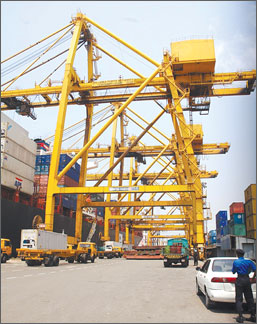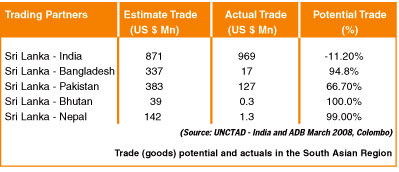Has SL-India trade saturated?
Rohantha N.A. Athukorala
A study done by UNCTAD-India with ADB has estimated the potential
trade between countries in the South Asia region is at 8,000 million
dollars based on the averages from 1995-2005, whilst the actual trade is
only 3,500 million dollars.
|

Rohantha Athukorala |
This gives us an idea of the potential trade that Sri Lanka can
harness only in South Asia, if proper facilitation is done by
organizations like SAARC.
This throws out a new dimension to Sri Lanka, given that there is new
business opportunities in the proposed CEPA agreement. This opportunity
will be initially between Sri Lanka and India and thereafter may be a
CEPA between Sri Lanka and Pakistan.
This new business opportunity can in fact off set some impact if a
fall out happens in trade in the EU and may be even US in the future.
*
UNCTAD(India)-ADB study reveals a Ďgoodsí trade negativity of
11.2 percent
* CEPA can reverse the trend but social issues must be avoided.
* Exports to India poised to cross $400 Mn in 2010 but below
2007.
* SLINTEC can drive Knowledge Economy to make SL fight Indian
companies
* Mini budget focuses on bringing in Economic Stability.
|
However, a point to note is that the issues faced on the EU/ US side
are not essentially trade related but of political nature.
Which is an interesting development that the world is witnessing
after a country has defeated one of the most ruthless terrorist
organizations of the world that has cost the country $ 200 billion. What
Sri Lanka requires is support from the world to recover and not
obstacles. Indian support is a must in this context.
South Asia Inter trade - 2 percent of GDP
Even though there is a 4,500 million dollar opportunity yet to be
captured in the South Asian region, the fact remains that inter-regional
trade accounts for only 5.5 percent or a mere 2 percent of the South
Asian Regions GDP.
In contrast in East Asia, this number stands at a mammoth 55 percent
of trade coming only from the East Asian countries which is an
indication of the strong integration that exists in that part of the
world.
A point to note is that the 55 percent trade accounts for a
staggering 20 percent of the GDP that further justifies that there is
opportunity for South Asian countries to grow by way of import/export
trade. The question is why has this not happened.
Trade Saturated with India?
Whilst the South Asian region lags behind the world on integration a
UNCTAD -India/ ADB study of 2008 throws out an alarming revelation that
the trade potential between Sri Lanka and India is at saturation point.
The study states that the trade potential is at 871 million dollars
whilst the actual trade(goods) based on the 1995-2005 average registers
969 million dollars.
This means that we have exhausted the potential trade with India. In
fact the indicator is negative at a 11.2 percent.
The need for CEPA?
May be this could be the reason why exports out of Sri Lanka are
hovering at a 500 million dollars in the last year with a meagre growth.
In fact in 2009 it declined to 324 million dollars.
Latest statistics further reveal that the SAARC countries contribute
to 17.1 percent of Sri Lankaís trade but, in this basket of goods 91
percent is from India which further justifies the trade saturation
argument.
|

The Colombo Port |
One way out is to quickly launch into new businesses with India
namely Energy, Transport and the all important service sector through
such agreements such as the CEPA.
However, this needs to be done with caution given that Sri Lanka is
coming out of a thirty year war and we need to give a chance for
businesses to strengthen and link with the Knowledge economy to drive
innovation.
SLINTECís work on Nano Technology and the scheduled patents that Sri
Lankan businesses will generate will sure help Sri Lanka to be
competitive against Indians.
May be we need to extent this facility to a Nano Park so that Sri
Lanka can take the high ground in South Asia.
Squeeze SL-India FTA?
Whilst from a macro end trade between India and Sri Lanka looks
saturated, if we do a detail analysis of the Free Trade Agreement (FTA)
with India, we see that the quota utilization of the strategic products
of Sri Lanka -Tea and Garments is below 10 percent which means that
there is more to squeeze out of the existing Indo Lanka FTA.
Some of the reasons cited for the Garments and Teas not going through
to India are not tariff barriers like delays in custom clearance, port
restrictions, necessity for several tests to be carried out in India
even though certificates are accompanied by the relevant authorities
which are essentially NTBs. But can this be due to the more deeper issue
of trade saturation is worth researching.
The logic of researching this is stronger is because the Indo-Lanka
trade agreement was the first FTA that each of our country have entered
into and, it was signed within four months with just four to five
consultations according to Professor Ranjan Ratna of the Indian
Institute of Foreign Trade (IIFT).
Which means that it is bound have many rough edges that need to be
corrected.
Normally India takes a minimum of two years to reach a trade
agreement with a minimum of twenty consultations by the two parties.
Some even after six years of consultation like India-Thailand FTA, is
yet to be concluded which gives us an idea of the limitation of the
Indo-Lanka FTA that was signed.
But an argument that some make is that a ten year honeymoon is ample
time to clear the bottlenecks to be resolved yet Sri Lanka continues to
hover around a 500 million dollar trade.

If we go back in time the original objectives of the FTA in the case
of India for instance it was based on the premise of a study done on the
regional comparative advantage (RCA), to drive an equitable trade
between regional partners so that each country can benefit from the
comparative advantages that one posses in a country.
The key obstacle to this end was the gradual removal of trade
barriers over a period of time.
Both countries agreed on a list of products which are in the negative
list, phasing out list and zero duty lists and the time frame to achieve
the end objective of freer trade between the countries.
The time frame was important so that suppliers can get adjusted to
international competition and vice versa.
Currently, except for the 429 products in the negative list of India,
all other products of Sri Lanka have a zero duty access technically into
India. From an Indian point of view other than for the 1180 products in
the negative list, all other products from India were entitled for duty
free access into Sri Lanka but why is the business growing exponentially
is the key question to be asked.
Could this direct to the logic of trade saturation, as per the UNCTAD/ADB
study of 2008. It is also an interesting argurement as to why we need to
sign up CEPA.
Is it an FTA issue then?
On the other hand we can also point out that serious trade did not
happen due to the problem of the architecture of the Indo Lanka FTA
which means it is a systemic issue than trade saturation.
For instance if we get into the brass-tacks of FTA, we see that a
number of projects invested in Sri Lanka increased from 34 to 105 and
then most of them closing down over time that actually off set the
benefits of international trade which would have had its own social
ramifications not only in Sri Lanka but also in India. And most of this
trade was based on tariff rate in equalities than actual comparative
advantages of trade which means the FTA in structure was flawed.
Apart from the Sri Lankan exports declining from $515 million to 324
million and the analogy of trade saturation, if we examine the 2.7
billion dollars of imports that come in from India, almost 70 percent of
them happens outside the FTA meaning that even without the FTA this
business would have happened.

Hence, one can question the architecture of the Indo-Lanka FTA that
was signed way back in 1998. Even if one discounts the petroleum
products that was imported which skews the import picture, the rest of
the products imported can be due to trade diversion than real imports.
Which means that the FTA needs to be re-crafted that will stimulate
trade between the two countries than actually trade saturation taking
place.
Whatever the reason may be, be it an FTA architecture issue or trade
saturation many Sri Lankan exporters have lost confidence on bilateral
agreements which are essentially designed to promote fair competition
and equitable benefits.
The process in place to address disputes settlement like the NTB
issues faced by Sri Lankan exporters are also very complicated and long
drawn.
For instance disputes of the SAARC countries are expected to be
resolved within 330 days, whilst in the case of our counter parts itís
different and more efficient like ASEAN countries resolve disputes
within 290 days and NAFTA in 310 days.
Which are also reasons why industrialists are questioning these types
of bilateral agreements.
Get help from WB and ADB
I feel we must stop hiding behind issues such as Non tariff barrier (NTBís)
or Political tariff barrier (PTBís) and face reality. Letís reach up to
organizations like ADB and WB who can support countries achieve the best
with trade and thereby reduce poverty levels by driving up employment.
Maybe institutions like these coming into the discussion will move
the discussion from the top line trade numbers like exports and imports
and drive towards more sustainable success stories like employment
created and reduction of poverty in a country.
Sri Lanka must give leadership
The time has come for us to accept reality and invest our time in
markets where we can expect quick returns.
Sri Lanka requires money coming into the country so that we can drive
down the budget deficit to below 5 percent. We need quick wins now and
not long reports and studies
Whilst the debate on what changes are required for CEPA continues, I
feel itís time for the Sri Lankan representatives to develop a strong
Chamber - Government dialogue forum so that we can see how far Sri Lanka
can exploit the current FTA for our benefit.
Thereafter Sri Lanka must champion CEPA with India and Pakistan to
suit Sri Lankan enterprises.
I strongly feel there is opportunity for more trade between countries
like Sri Lanka and India and for driving stronger integration in the
South Asian region but it requires a strong will from the policy makers
of SAARC. |



